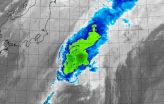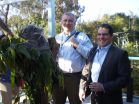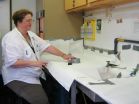(Press-News.org) PITTSBURGH--Speed is an asset for a predator. Except when that predator runs so fast that it essentially blinds itself.
The tiger beetle, relative to its size, is the fastest creature on Earth. Some of these half-inch-long beetles cover about 120 body lengths per second (at about five miles per hour). The fastest human can do about five body lengths. To take the sprinting gold from the tiger beetle, a person would have to hit 480 miles per hour.
BUT! The tiger beetle has a problem. At peak speeds, everything becomes a blur. They can't gather enough light with their eyes, and vision is compromised. It can still perceive the pursued but not at all clearly.
The University of Pittsburgh's Daniel Zurek, a postdoctoral researcher in Nathan Morehouse's lab in the Department of Biological Sciences in the Kenneth P. Dietrich School of Arts and Sciences, is looking into how the tiger beetle's speed-related vision issues correlate with when it opens and closes its vicious mandibles in pursuit of supper.
Is it just guessing? Hoping that its Jaws of Death are ready to crush prey when it inevitably catches up?
No, Zurek says in a new paper published Nov. 5 in Biology Letters.
"We're asking in what situations do the mandibles open and close," Zurek says. "They're trying to catch something, so they want to be sure that their jaws are open and close on contact." But, he adds, in their obstacle-riddled habitat, it's probably not a good idea to keep them open all the time, lest the mandibles snag something, delaying the beetle and permitting escape.
"Is it a matter of distance (to prey), the size (the prey) appears on the retina, the projected time to collision? There are lots of variables," he says.
Using a dummy piece of prey (a plastic bead on a string), Zurek let the beetles give chase and recorded their hunting efforts in super slow-mo. As the beetle begins to catch up to the escaping dummy prey, the contracting image of the prey as perceived by the beetle begins to expand, which is the cue for the beetle to open its jaws, Zurek found. And as the image begins to recede, the jaws close.
This research, Zurek says, reveals a novel and potentially widespread mechanism for how behavioral decisions can be made based on visual "rules" in dynamic situations, where both the observer and the target are moving.
INFORMATION: END
The tiger beetle: Too fast to see
Pitt biologist looks into how the speedy predator pursues prey
2014-11-06
ELSE PRESS RELEASES FROM THIS DATE:
Black, Hispanic kids underrepresented in autism identification
2014-11-06
LAWRENCE -- The number of children diagnosed with autism has increased in recent years, but a new study co-authored by a University of Kansas professor shows that while the number of students with autism increased in every state from 2000 to 2007, black and Hispanic children were significantly underrepresented.
Jason Travers, assistant professor of special education, co-authored a study that analyzed administrative identification of autism in every state under the Individuals with Disabilities Education Act for the years 2000 and 2007. The disparity in the odds of white ...
Who will come to your bird feeder in 2075?
2014-11-06
The distribution of birds in the United States today will probably look very different in 60 years as a result of climate, land use and land cover changes.
A new U.S. Geological Survey study predicts where 50 bird species will breed, feed and live in the conterminous U.S. by 2075. While some types of birds, like the Baird's sparrow, will likely lose a significant amount of their current U.S. range, other ranges could nearly double. Human activity will drive many of these shifts. The study was published today in the journal PLOS ONE.
"Habitat loss is a strong predictor ...
NASA sees Tropical Storm Nuri resemble a frontal system
2014-11-06
NASA's Terra satellite passed over Tropical Storm Nuri on Nov. at captured an infrared picture of the storm. The storm looked more like a frontal system as it stretched from northeast to southwest.
The Moderate Resolution Imaging Spectroradiometer or MODIS instrument that flies aboard NASA's Terra satellite flew over Nuri on Nov. 6 at 1240 UTC (7:40 a.m. EST). The MODIS image showed some strong thunderstorms remaining in a small area around Nuri's center, but the storm appeared stretched out from northeast to southwest. Wind shear was affecting the storm, stretching it ...
'Rewriting' the way to make natural drug compounds
2014-11-06
(SALT LAKE CITY)--One of the big hurdles in bringing drugs to market is the difficulty of producing large enough quantities of potential compounds to conduct clinical trials. This is particularly true with compounds made by organisms, which usually are produced in exceedingly small amounts and are difficult to synthesize in the laboratory.
Researchers from the University of Utah College of Pharmacy have made an important stride in addressing those problems. In a study in ACS Synthetic Biology, researchers led by Eric W. Schmidt, Ph.D., professor of medicinal chemistry, ...
NASA see birth of Tropical Cyclone 5B in Bay of Bengal
2014-11-06
The fifth tropical cyclone of the Northern Indian Ocean season formed in the Bay of Bengal as NASA's Terra satellite passed overhead and captured an image of the storm.
When Terra passed over Tropical Cyclone 5B on Nov. 6 at 05:05 UTC (12:05 a.m. EST), the MODIS instrument aboard took a visible image of the storm. The MODIS image showed a concentrated storm with strong thunderstorms circling tight around the center and in the northeastern quadrant.
By 1500 UTC (10 a.m. EST), Tropical Cyclone 5B was located near 13.4 north latitude and 87.9 east longitude. That's about ...
Study highlights prevalence of mistreatment between nursing home residents
2014-11-06
NEW YORK (November 6, 2014) -- Inappropriate, disruptive, or hostile behavior between nursing home residents is a sizable and growing problem, according to new research from Weill Cornell Medical College and Cornell University.
The study found that nearly one in five nursing home residents were involved in at least one negative and aggressive encounter with one or more fellow residents over the previous four weeks. These included acts of verbal or physical abuse, inappropriate sexual behavior, or invasion of privacy, among other incidents, known collectively as resident-to-resident ...
Denying problems when we don't like the political solutions
2014-11-06
DURHAM, N.C. -- There may be a scientific answer for why conservatives and liberals disagree so vehemently over the existence of issues like climate change and specific types of crime.
A new study from Duke University finds that people will evaluate scientific evidence based on whether they view its policy implications as politically desirable. If they don't, then they tend to deny the problem even exists.
"Logically, the proposed solution to a problem, such as an increase in government regulation or an extension of the free market, should not influence one's belief ...
Koala study reveals clues about origins of the human genome
2014-11-06
Eight percent of your genome derives from retroviruses that inserted themselves into human sex cells millions of years ago. Right now the koala retrovirus (KoRV) is invading koala genomes, a process that can help us understand our own viral lineage and make decisions about managing this vulnerable species.
In a recent study scientists from the University of Illinois discovered that 39 different KoRVs in a koala's genome were all endogenous, which means passed down to the koala from one parent or the other; one of the KoRVs was found in both parents.
Koalas are the ...
Retaining military veteran employees is all about the right fit
2014-11-06
It's a difficult career transition that can lead to more professional frustration and shorter tenure on the job for many of the newest generation of veterans employed with the U.S. Department of Veterans Affairs (VA) compared to their non-veteran co-workers.
New research from the University of Cincinnati is helping VA analyze the process of reintegrating veterans into civilian careers and evaluate methods for easing that transition. That's good news for all veterans as the nation prepares to observe Veterans Day on Nov. 11.
"This period of time within our labor force ...
Nutrients that feed red tide 'under the microscope' in major study
2014-11-06
The "food" sources that support Florida red tides are more diverse and complex than previously realized, according to five years' worth of research on red tide and nutrients published recently as an entire special edition of the scientific journal Harmful Algae.
The multi-partner project was funded by the National Oceanic and Atmospheric Administration's ECOHAB program* (described below) and included 14 research papers from seven institutions.
The research team studied four red tide blooms caused by the harmful algae species Karenia brevis in 2001, '07, '08 and '09, ...
LAST 30 PRESS RELEASES:
Making lighter work of calculating fluid and heat flow
Normalizing blood sugar can halve heart attack risk
Lowering blood sugar cuts heart attack risk in people with prediabetes
Study links genetic variants to risk of blinding eye disease in premature infants
Non-opioid ‘pain sponge’ therapy halts cartilage degeneration and relieves chronic pain
AI can pick up cultural values by mimicking how kids learn
China’s ecological redlines offer fast track to 30 x 30 global conservation goal
Invisible indoor threats: emerging household contaminants and their growing risks to human health
Adding antibody treatment to chemo boosts outcomes for children with rare cancer
Germline pathogenic variants among women without a history of breast cancer
Tanning beds triple melanoma risk, potentially causing broad DNA damage
Unique bond identified as key to viral infection speed
Indoor tanning makes youthful skin much older on a genetic level
Mouse model sheds new light on the causes and potential solutions to human GI problems linked to muscular dystrophy
The Journal of Nuclear Medicine ahead-of-print tip sheet: December 12, 2025
Smarter tools for peering into the microscopic world
Applications open for funding to conduct research in the Kinsey Institute archives
Global measure underestimates the severity of food insecurity
Child survivors of critical illness are missing out on timely follow up care
Risk-based vs annual breast cancer screening / the WISDOM randomized clinical trial
University of Toronto launches Electric Vehicle Innovation Ontario to accelerate advanced EV technologies and build Canada’s innovation advantage
Early relapse predicts poor outcomes in aggressive blood cancer
American College of Lifestyle Medicine applauds two CMS models aligned with lifestyle medicine practice and reimbursement
Clinical trial finds cannabis use not a barrier to quitting nicotine vaping
Supplemental nutrition assistance program policies and food insecurity
Switching immune cells to “night mode” could limit damage after a heart attack, study suggests
URI-based Global RIghts Project report spotlights continued troubling trends in worldwide inhumane treatment
Neutrophils are less aggressive at night, explaining why nighttime heart attacks cause less damage than daytime events
Menopausal hormone therapy may not pose breast cancer risk for women with BRCA mutations
Mobile health tool may improve quality of life for adolescent and young adult breast cancer survivors
[Press-News.org] The tiger beetle: Too fast to seePitt biologist looks into how the speedy predator pursues prey




